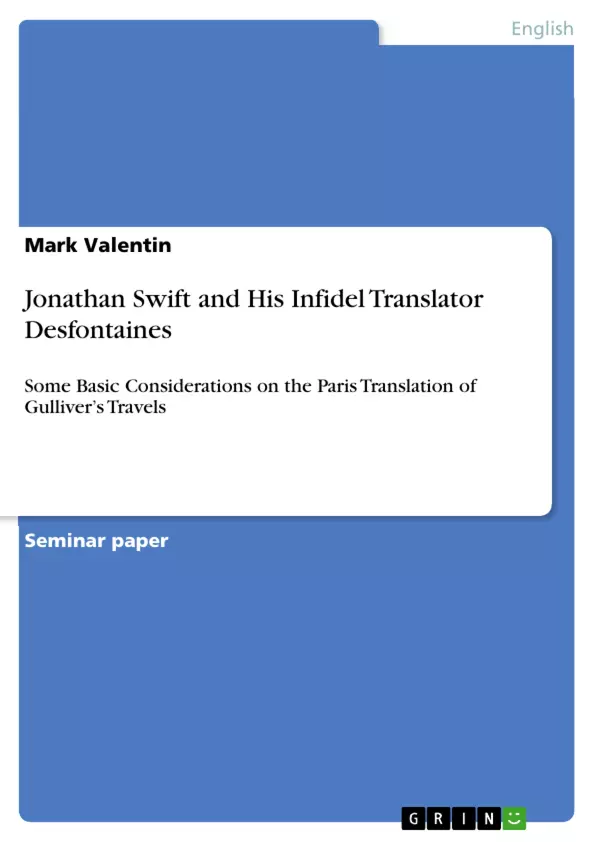The reception process of a literary work – especially a very popular one – can be seen as a scientific subject absolutely worth focusing on in an academic course. This paper tries to contribute to the analysis of Jonathan Swift’s reception on the continental book market by concentrating on the relation between a widespread French translation of Gulliver’s Travels and the original English work. In this context, one has to be aware of the fact that there are two translations of Swift’s work in 18th century France, an anonymous one published at The Hague in January 1727 and a more widespread version (with a record of 180 editions in the 1920s) translated by Desfontaines in April 1727. This paper concentrates on the Desfontaines’s version of Gulliver’s Travels, not only because of its higher popularity in general, but also due to its character as a “belle infidèle” . On the one hand, it will be the author’s aim to give some general information on the Abbé’s version. In this context, not only literature on the topic, but also the correspondence between Swift and his infidel translator are relevant aspects. On the other hand, the comparative analysis of a few passages concerning child-raising shall concretely exemplify Desfontaines’s intentions.
Inhaltsverzeichnis (Table of Contents)
- I. Introduction
- II. Swift's Gulliver's Travels and Desfontaines's 'belle infidèle'
- III. Conclusion
- IV. List of Works Cited
Zielsetzung und Themenschwerpunkte (Objectives and Key Themes)
This paper explores the reception of Jonathan Swift's Gulliver's Travels on the continental book market, specifically focusing on the relationship between the widely-read French translation by Desfontaines and the original English text. The analysis examines Desfontaines's translation as a "belle infidèle" (a beautiful betrayal), examining the translator's intentions and how his version reflects French Enlightenment values.
- The reception of Gulliver's Travels in 18th-century France
- Desfontaines's translation as a "belle infidèle" and its implications
- Desfontaines's perspective on Swift's work and the "bon goût français" (French good taste)
- The role of the translator's preface in revealing his intentions
- A comparative analysis of select passages concerning child-raising
Zusammenfassung der Kapitel (Chapter Summaries)
I. Introduction
This chapter introduces the paper's focus on the reception of Gulliver's Travels in France, emphasizing the importance of studying translation processes in understanding literary works. It highlights the two main French translations of Swift's work, focusing on Desfontaines's version due to its popularity and character as a "belle infidèle."
II. Swift's Gulliver's Travels and Desfontaines's 'belle infidèle'
This chapter provides background information on Desfontaines, his career as a translator and polemicist, and his position as editor of the "Journal des Savants." It discusses how Desfontaines's perspective as a French Enlightenment thinker influenced his translation of Gulliver's Travels, emphasizing his desire to adapt the work to the "bon goût français." The chapter also examines the popularity of Swift's work in France and how Desfontaines's translation reflects his attempts to align the text with French sensibilities.
Schlüsselwörter (Keywords)
The primary focus of this paper lies in the reception of Gulliver's Travels in France, with particular emphasis on Desfontaines's translation, its character as a "belle infidèle," and the translator's intentions. Key themes include the influence of the French Enlightenment, the concept of "bon goût français," and the relationship between translation and adaptation. The analysis includes a comparative study of select passages from the original and translated texts.
- Quote paper
- B.A. Mark Valentin (Author), 2011, Jonathan Swift and His Infidel Translator Desfontaines , Munich, GRIN Verlag, https://www.grin.com/document/167983



